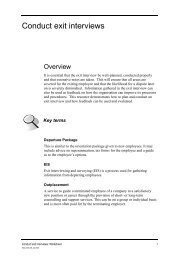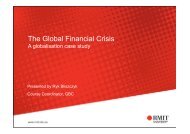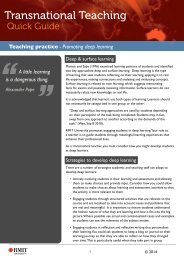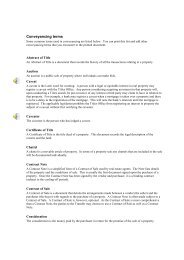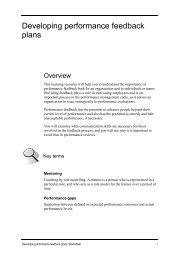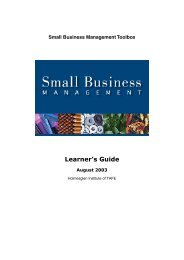Approaching student-centred learning and teaching - RMIT University
Approaching student-centred learning and teaching - RMIT University
Approaching student-centred learning and teaching - RMIT University
You also want an ePaper? Increase the reach of your titles
YUMPU automatically turns print PDFs into web optimized ePapers that Google loves.
Transnational TeachingQuick GuideTeaching practice - <strong>Approaching</strong> <strong>student</strong>-<strong>centred</strong> Learning <strong>and</strong> TeachingEmbracing <strong>student</strong> centerednessIf we valueindependence, if weare disturbed by thegrowing conformity ofknowledge, of values,of attitudes, whichour present systeminduces, then wemay wish to set upconditions of <strong>learning</strong>which make foruniqueness, for selfdirection,<strong>and</strong> for selfinitiated<strong>learning</strong>.Carl RogersAcademic <strong>and</strong> <strong>teaching</strong> staff can adopt two orientations in their <strong>teaching</strong>: ateacher <strong>centred</strong>/content orientation or a <strong>student</strong> <strong>centred</strong>/<strong>learning</strong> orientation(Kember, 1997). At <strong>RMIT</strong> we promote <strong>student</strong>-<strong>centred</strong> <strong>learning</strong> approaches soit is important to be familiar with what it means to adopt a <strong>student</strong>-<strong>centred</strong> or<strong>learning</strong> orientation.The term <strong>student</strong>-<strong>centred</strong> <strong>learning</strong> implies a conceptual shift from I will tellyou this <strong>and</strong> therefore you will learn to I want to help you learn in ways which areeffective for you <strong>and</strong> to meet your needs.Transnational academic <strong>and</strong> <strong>teaching</strong> staff need to be aware that some<strong>student</strong>s may be more familiar with teacher-<strong>centred</strong> approaches. When<strong>teaching</strong> in <strong>RMIT</strong> programs, part of your role will be to assist <strong>student</strong>stransition from a teacher-<strong>centred</strong> approach to a <strong>student</strong>-<strong>centred</strong> approach to<strong>learning</strong>.Optimising the conditions in which all <strong>student</strong>s can learn effectively is animportant function of <strong>teaching</strong>. This requires you to:• Create a psychologically safe <strong>learning</strong> environment• Build supportive <strong>and</strong> constructive teacher/<strong>student</strong> relationships, <strong>and</strong>• Accommodate the diversity of <strong>learning</strong> styles <strong>and</strong> needs that exist withinyour <strong>student</strong> group.Creating psychologically safe <strong>learning</strong> environmentsStudents need instructional <strong>and</strong> emotional support to learn effectively <strong>and</strong>successfully. They need to:• Feel comfortable with you <strong>and</strong> with other <strong>student</strong>s.• Feel that you <strong>and</strong> other <strong>RMIT</strong> staff care about their <strong>learning</strong> <strong>and</strong> success.• Feel confident that they can take risks <strong>and</strong> will not feel shame orembarrassment when they make errors or display initial incompetence.• Be confident that they will be treated fairly <strong>and</strong> with respect.• Feel that there is sufficient flexibility in <strong>learning</strong> approaches that will allowfor them to construct meaning in their own unique, individual way.• Believe that they can be successful in the program.1 © 2014
All academic <strong>and</strong> <strong>teaching</strong> staff must be sensitive to the impact that feelingsof anxiety, shame <strong>and</strong> embarrassment may have on a <strong>student</strong>’s willingness toengage in classroom activities. If <strong>teaching</strong> in a transnational setting, you needto be aware that in many societies respect for seniority <strong>and</strong> the need to savingface may impact on the level of confidence <strong>student</strong>s have in participating insome classroom activities. More information about how culture may impacton a <strong>student</strong>’s sense of psychological safety is available from the TransnationalTeaching Quick Guide <strong>Approaching</strong> cultural diversity.In 1968 Rosenthal <strong>and</strong> Jacobson demonstrated in their “Pygmalion in theClassroom” study that “teacher expectations can act as self-fulfilling propheciesbecause <strong>student</strong> achievement comes to reflect their expectations” (Pintrich &Schunk, 1996, p.347).Students need to feel part of their <strong>learning</strong> community <strong>and</strong> you must create anatmosphere that encourages them to support one another in their <strong>learning</strong>. Tocreate this sense of belonging in the group you need to encourage active communicationbetween <strong>student</strong>s through team work <strong>and</strong> communication activities,<strong>and</strong> through your own encouragement of them as part of your community.Build supportive & constructive teacher/<strong>student</strong>relationshipsA constructive teacher/<strong>student</strong> relationship is important for optimal<strong>learning</strong>. Students need to feel respected <strong>and</strong> that their <strong>learning</strong> needs areaccommodated. It can be difficult to get to know all <strong>student</strong>s personally if youhave a large class however even when you have a large class it is worth payingattention to both the common <strong>and</strong> diverse characteristics of the <strong>student</strong> group.When designing <strong>learning</strong> activities it is important to consider the diverse rangeof life experiences that <strong>student</strong>s bring to the classroom. These life experienceswill influence the way <strong>student</strong>s process new <strong>learning</strong>; they will often search formeaning <strong>and</strong> analyse <strong>and</strong> interpret the concepts <strong>and</strong> ideas you present basedon their past experiences <strong>and</strong> what they already know.You can gain an appreciation of your <strong>student</strong>s’ past <strong>learning</strong> <strong>and</strong> experiences byengaging them in dialogue about how their past <strong>learning</strong> <strong>and</strong> experiences mayshape the way they think about the knowledge <strong>and</strong> information you present.Vella (2001) presents some useful ideas on how you can do this. Examples ofquestions or tasks you use include asking <strong>student</strong>s to:• Think about how the topic relates to their own life experiences.• Identify something that st<strong>and</strong>s out for them in the new knowledgepresented.• Underline key words they would like to discuss with the group.• Engage in dialogue about the new knowledge.• Engage in an activity that helps them to construct their own content.2 © © 2014
Underst<strong>and</strong>ing differences in preferred <strong>learning</strong> stylesAlong with diverse life experiences <strong>and</strong> considerable variation in <strong>student</strong>s’knowledge, skills, cultural background <strong>and</strong> levels of maturity, <strong>student</strong>s also cometo the classroom with a range of preferred <strong>learning</strong> styles. As a result teachersneed to thoughtfully select a variety of <strong>learning</strong> activities <strong>and</strong> tools that willengage all <strong>student</strong>s in <strong>learning</strong>.A <strong>student</strong>’s preferred <strong>learning</strong> style will influence which <strong>learning</strong> activities theywill respond best to so it is necessary for teachers <strong>and</strong> academic staff to use arange of <strong>learning</strong> approaches <strong>and</strong> activities.A variety of <strong>learning</strong>styles requires a varietyof <strong>learning</strong> activitiesAdult <strong>learning</strong> theorists Wolf <strong>and</strong> Kolb (1984) have provided useful modelsto assist underst<strong>and</strong> the differences in <strong>learning</strong> styles. Wolf <strong>and</strong> Kolb’s modeldescribes the four <strong>learning</strong> styles reflected in the following table.Style of LearnerActivistsEngagement strategyRespond to a challenge, new experiences <strong>and</strong>problems, excitement, sense of freedom in <strong>learning</strong>.To accommodate Activists design <strong>learning</strong>experiences that enable <strong>student</strong>s to get involved in ah<strong>and</strong>s-on, practical project. Structure <strong>learning</strong> activitiesallowing time to observe, reflect <strong>and</strong> think.ReflectorsTo accommodate Reflectors provide <strong>student</strong>swith readings, case studies <strong>and</strong> examples. DVD clips<strong>and</strong> audio recordings that provide <strong>student</strong>s withthe opportunity observe or listen to others with adepth of experience in the field of study <strong>and</strong> thendiscuss their reflections can also be very useful. Youmight provide discussion questions to guide <strong>student</strong>reflection <strong>and</strong> discussion.TheoristsAppreciate clear aims <strong>and</strong> logical structure withtime for methodical exploration <strong>and</strong> opportunity toquestion.To accommodate Theorists provide lectures orpresentations that logically outline theories <strong>and</strong>conceptual frameworks. Theorists also enjoy <strong>learning</strong>through reading well-research books <strong>and</strong> articles soit is worth providing additional readings or referencesfor these <strong>student</strong>s. Provide relevant <strong>and</strong> relevant <strong>and</strong>practical <strong>learning</strong> activities where theory can be putinto practice.3 © © 2014
Style of LearnerPragmatistsEngagement strategyTo accommodate Pragmatists provide succinct,practically-orientated readings. You may also needto help <strong>student</strong>s put new <strong>learning</strong> to practical use.Pragmatists will respond well to real-life projects <strong>and</strong>like to get feedback <strong>and</strong> advice on specific things theycan do to improve.Adapted from “Learning Styles” in Fry, H., Ketteridge, S., & Marshall, S. (1999)Cultural backgroundThe cultural backgrounds of <strong>student</strong>s will influence their expectations ofteachers <strong>and</strong> how they engage in the classroom. A more in-depth discussion ofways of structuring classroom activities to accommodate cultural differencesis available in the Transnational Teaching Quick Guide: <strong>Approaching</strong> CulturalDiversity.Useful resourcesSupport is available from your Deputy Head of School (Learning & Teaching) orequivalent. Your College Academic Development Group or <strong>learning</strong> & <strong>teaching</strong>specialist can also provide advice, support <strong>and</strong> professional development.<strong>RMIT</strong> <strong>University</strong>’s practical guides to <strong>teaching</strong> will help your plan <strong>and</strong> improveyour <strong>teaching</strong> practice:http://www.rmit.edu.au/<strong>teaching</strong>/practicalBlumberg, P. (2008) Developing Learner-Centered Teachers: A Practical Guidefor Faculty. San Francisco: Jossey-Bass.Felder, R. M. <strong>and</strong> Brent R. (2005) “Underst<strong>and</strong>ing Student Differences”, Journalof Engineering Education, 94 (1), 57-7.Vella, J. (2001. Taking Learning to Task. San Francisco: Jossey Bass.Wolf, D.M <strong>and</strong> Kolb, D.A (1984) ‘Career development, personal growth <strong>and</strong>experiential <strong>learning</strong>’ in Kolb. D., Robin, I.M <strong>and</strong> McIntyre, J.M., OrganisationalPsychology.The Learner-Centered Teaching Series of the <strong>University</strong> of Oregon provideshelpful links to a variety of discussions, strategies <strong>and</strong> tips on the <strong>student</strong><strong>centred</strong><strong>teaching</strong> classroom:http://tep.uoregon.edu/workshops/teachertraining/learnercentered/learnercentered.html<strong>RMIT</strong>’s video series “Perspectives on Learning <strong>and</strong> Teaching” presents shortvignettes about <strong>student</strong>-<strong>centred</strong> <strong>learning</strong>, learner diversity, <strong>student</strong> engagement<strong>and</strong> preparing to teach:https://www.dlsweb.rmit.edu.au/bus/public/good<strong>teaching</strong>/4 © © 2014




